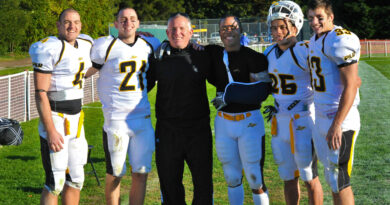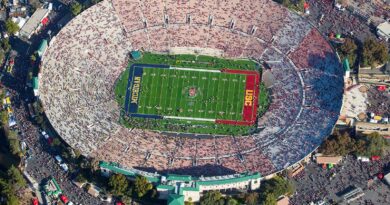Time to Dust Off the MLB Record Books
I was 8 years old during the great home run chase of 1998. I recall night after night, tuning in to watch Sammy Sosa and Mark McGwire stroke pitch after pitch over the fence. They each had their ways; McGwire, stoic, with an effortless swing, like a Jedi persuading the ball to fly away; Sosa was aggressive, attacking, making the ball jump off the bat, then himself jumping, jumping, as if extending the ball’s flight with each leap.
Watching that home run race was one of the most exciting times of my life. So as I sit here, now thinking of all the records that still stand, I wonder which can be broken. I go through record after record, each time seeing the same pattern emerge: 1897, 1902, 1894, 1927, 1914…
Our records are old. But not just that, our statistics are old. As we step into this new era of baseball with replay, three batter minimums, shifts, and launch angle, what happens to the old records? Baseball statisticians continue to invent new ways to track value that seemingly make old stats obsolete. The 20-win mark no longer lives as a benchmark for a CY Young. Wins aren’t even a category in my fantasy baseball ROTO league anymore. Change happens, whether it is good or bad is not what I’m after. I want to know how we will move on with records that will never be broken. In basketball, football, soccer and hockey, records are becoming more attainable. Baseball is the only major sport where its records are trending toward untouchable, and some even irrelevant to the game we see today.
In 1894 Hugh Duffy hit .439 to set a new batting average record. That record still stands today. Batters have hit over .400 just 28 times in the recorded history of baseball. Of those 28 times, the most recent was in 1941 when Ted Williams hit .405. Before Williams broke .400, the last time a player hit over that mark was Bill Terry in 1930. He hit .401. Since Williams, the two closest marks to .400 were .393 by Tony Gwynn in 1994, and .389 by George Brett in 1980. In total, players have hit over .370 just 11 times since Ted Williams hit .405, seven of those coming between 1993 and 2004. Since 2010, Josh Hamilton has the highest single season BA at .359.
Even three years ago, .439 was daunting, but not impossible. Now I’m not going to get into a philosophical debate—yes technically anything is possible—but how likely is it? I mentioned earlier that wins had been erased from my ROTO league this past season. Batting average was almost nixed too. In the last few years OBP, SLG, BABIP have almost completely obliterated the value of BA. To a large amount of “baseball guys” batting average is a thing of the past. So if the emphasis isn’t there, why go for it? Obviously you would think if a player is killing OBP, SLG, and BABIP, his BA will be up as well. But these statistics have not just shifted statistician’s pencils; they’ve shifted the majority of batter’s approaches to the plate. Factor in the rising velocity coming from the mound and algorithmic shifts in the field, and you have a record slipping seemingly out of view. Aberrations happen—that’s most often what a record is. Every blue moon an Ichiro or a Tony Gwynn comes along. This is not to say the record won’t get broken, but the landscape is changing quickly.
One record that will (probably) never be broken is the all-time single-season runs record. Billy Hamilton (not the one you know) scored an unimaginable 194-198 runs in 1894. I say 194-98 because it’s a debated stat, some have 194, others have 196 and still others have it as 198. Regardless of the actual number it is still about 20 runs more than the next highest total. These days if someone scores 100 times they’ve done a great job. To put the runs record in perspective, of the top 50 run scoring seasons, 30 are pre 1900, just two are post 1930’s, and just one lone season happened after 1950. By the way, you will never guess who did it…
Jeff Bagwell. Borderline Hall of Famer and borderline accused steroid user, Bagwell scored 152 runs in the 2000 season. The next closest after 1950 would be Bagwell’s teammate, Craig Biggio, who crossed the plate 146 times in the ’97 season (Ricky Henderson also scored 146 times in the 1985 season, and Sammy Sosa in the 2001 season).
Since 1990 only seven different players have even eclipsed 140 runs in a season: Chuck Knoblauch 140 (1996), Alex Rodriguez 141 (1996) and 143 (2007), Ellis Burks 142 (1996), Larry Walker 143 (1997), Jeff Bagwell 143 (1999) and 152 (2000), Sammy Sosa 146 (2001), Craig Biggio 146 (1997). Since 2010 the highest single season mark is 137 by Charlie Blackmon in 2017.
Stolen bases, RBIs, it’s essentially the same story; stats dominated by the past. The game is flat out played differently. Analytics and chance rule dugouts. Risk management, load management, science and math reign supreme. Small ball has all but been replaced by the all-or-nothing era. As it fades out of sight, so do the stats that marked those times.
The pitching record books can almost be split in half. The single season records for Wins (60), CG (75), SHO (16), IP (680), and even SO (513) are all products of the old school thinking. Now it’s WHIP, OOBP, OSLG, Whiff Rate, and Velocity that jump off the stat page.
There will always be players who change the game, who force others to adapt. There will be moments like the 1998 home run chase that force the game to ask questions and change. But as we venture into a new era of high-octane pitchers and batters who hit the ball not just 400 feet out, but 200 feet high, as we find ourselves watching four outfielders at times and five infielders at others, how do we measure the record books, when the measure of the game has changed so much? Because records are only there to be broken.




